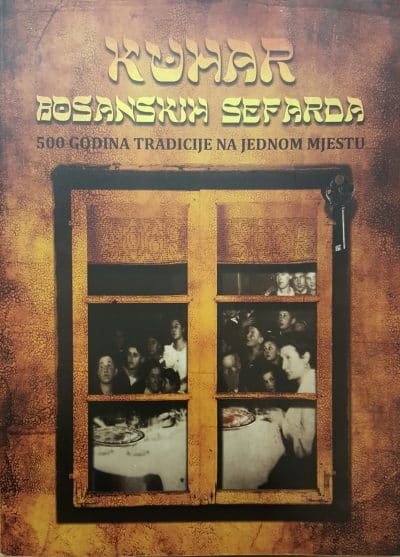BOSNIAN SEPHARDS COOKBOOK
500 Years of Tradition (in one place/space)

Sephard Cuisine in Bosnia
Key of Spain
Reminescence on Spain is still alive among the decedents of Sephards, including the ones in Bosnia and Herzegovina.
There is a legend telling that the Jewish families expelled from Spain in 15th century kept the keys of their homes in Toledo (Spain), and many years later one of their decendents returned to Toledo, found the home, turns the key, and opens the door.
«Sephardic» is term used to describe Jewish people which are decendents of Jews expelled from the Pyrenean (Iberian) peninsula 1492, actually 1496. In fact, even today Hebrew word for Spain is «Sefarad.»
Sephardic culture was under the influence of Spanish culture in many ways, especially in regard to Spanish cuisine. As a result, many Sephardic recipes can be found among those of the Mediterranean’s. Sephardic recipes usually consist of Kosher food, although some Jewish recipes may somewhat vary during the holidays of Passover, when some of vegetables are not used in preparation of some Sephardic foods (dishes).
In Spanish city of Toledo, the recipe on making a marzipan recipe a jewish way is well preserved. Marzipan is a delicatessen consisting of sugar and almonds. Toledo has been traditionally a city with large Jewish population and many Jewish traditions are still well present. Nowadays, Lastname «Toledano» still exist, and its origin is Sephardic.
In Jewish tradition, using Fish instead of meat on Fridays has been long practiced in Spain. Jews traditionally eat fish, beef, roasted chicken, and on Fridays dishes are prepared for Saturday (Shabbat).
In Andalusia are used many typically Jewish recipes, which still remain in its original form, even after such a long time.
Friar’s ears (Orejas de Fraile) is a typical Galician delicatessen of Sephardic origin. This coffee pastry consists of flour, eggs, milk, oven baked, topped lightly with honey. Friar’s ears originates from Haman’s ears (Hamantash), a Sephardic pastry.
Aside from Jewish food, in Spain among many recipes one finds also those including almonds, pine nuts, honey, spices, and other ingredients originating in Sephardic Kosher foods (dishes).
One thousand and five hundred years, Sephardic diaspora has succeeded to preserve its Culinary tradition and Kosher laws around the world.
Sephardic cuisine is a treasure full of live, classic seasonal recipes and healthy foods which includes use of fresh fruits and vegetables; grains and beans, small portions of meat, poultry, and fish, and healthy mix of herbs and spices. Its also a story about how Jewish cooks successfully carried local ingredients, techniques, and traditions in their new homeland and preserved in their cuisines. All this was preserved with gratitude to, exceptional women, our nonnas (italian: grandmothers) and great grandmothers, which preserved and passed on this tradition jealously to their daughters and grandchildren.
Bosnia and Herzegovina is located in the back of Mediterranean and remarkably connected with those which bring to it fresh fruits, vegetables, and fish from the Adriatic sea between Dubrovnik and Split (Croatia). Therefore, looking into the diversity of Sephardic cuisine in Sarajevo (Bosnia and Herzegovina), the city which has been known as «Little Jerusalem» – «Jerusalajim Cika», we notice that wide spectrum of dishes, which, up to now, in an unordinary and completely new way, invite us, at the same time, to taste (feel) Mediterranean cuisine and Oriental influence in Spanish way. Yet (because), here all is intertwined; from the dish names to adopting local dishes or local spices, and a new cuisine has been created – a cuisine of Bosnian Sephards.
Sephardic woman adopted Bosnian cuisine and it has become a component of traditional Sephardic cuisine. So we can find here a typical Bosnian dish Japrak (pron. Ya-p- raa- k, Turkish – ‘grape’ leaf) , which in Sephardic cuisine receives only Spanish word ending known as Japrakis. Similarly Bosnian Halwa with only small (recipe) changes enters Sephardic cuisine and is known as Hanukkah Halwa. Sephardic cuisine was preserved granddaughters and great granddaughters of those diligent Sephards (women) which knew how to preserve Spanish traditions, to use it and mix it with local – Bosnian tradition by adding each time something from their rich tradition, creating in such a way completely a new autochthonous cuisine of Bosnian Sephardic Jews.
Yet (because), regardless of the amount of effort, most of these dishes, it is (almost) impossible to find a cuisine of other Sephardic communities. And even if you manage successfully to find a dish based on its name, it is still not likely the same dish prepared by the Bosnian Sephardic Jews. In fact, more likely in most cases, its not the same dish – different ingredients, different preparation (steps).
There are, in this cookbook, also dishes typical for only Bosnian Sephardic Jews, which are not made elsewhere, and many Jews are not even familiar with the dishes names and existence.
So, one can find (in the cookbook) forgotten specialties of duck meat, but also autochthonous (native) recipe for making a «Kackavalj» cheese, which Jews brought to Bosnia from Spain the afar.
The Bosnian Sephard Cookbook, is a latest attempt to preserve traditional Bosnian Sephardic Cuisine, to transfer it to the new generations , and to present to the world all its values, peculiarity, and originality.
Authors
MIRJAM AND ELI TAUBER
Mirjam Tauber is a Sarajevo-born artist and Sephardic cook. Mirjam worked as a teller at a bank until the beginning of the Siege of Sarajevo when she and her family fled to Israel. In the early 00s, after returning to Sarajevo, Mirjam began organizing a Night of Sephardic Cuisine. The annual event draws hundreds of people to Novi Hram, a former Jewish synagogue and now Museum in Sarajevo. In 2016 the event celebrated its tenth anniversary and Mirjam published a cookbook of Sephardic Bosnian Recipes.
~
Dr. Eli Tauber is an author and historian who lives in Sarajevo, Bosnia and Herzegovina. He began his career as a journalist for the Balkan paper Oslobodjenje but has since been employed by the Institute for Research of Crimes Against Humanity and International Law at the University of Sarajevo, and is the author of several books on the topic of Jewish history in Bosnia. His books, written in the Bosnian/Serbo/Croatian language, include: The Illustrated Lexicon of Judaism, History, Religion and Customs; When Neighbors were Real Human Beings; The Jewish Press in Bosnia and Herzegovina; Jewish Surnames in Bosnian Archives; The Holocaust in Bosnia and Herzegovina; and The Judeo Spanish Language in Bosnia and Herzegovina. During the Bosnian War in the 1990s, Eli and Mirjam fled to Israel where they lived for 12 years. In 2004 they resumed living in their home in the heart of old Sarajevo.
As part of the Sarajevo450 Project, Eli visited St. Louis, Missouri (Aug 2016) and through a series of community lectures and events shared stories from over 450 years of Jewish and Muslim community in Bosnia. He also share excerpts from his book When Neighbors were Real Human Beings, which documents the stories of those who saved Jewish lives (of whom many were Muslim) during World War II. The story of Eli’s own mother, Estela, is included in the collection.
Fuente: bosniansephardiccuisine.com
 eSefarad Noticias del Mundo Sefaradi
eSefarad Noticias del Mundo Sefaradi

